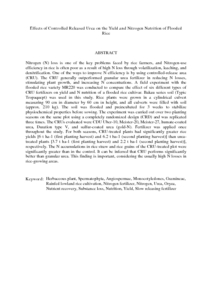Citation
Kiran, Jeet Kaur and Yusop, Mohd Khanif and Husin, Amminudin and Abd Rahim, Anuar
(2010)
Effects of Controlled Released Urea on the Yield and Nitrogen Nutrition of Flooded Rice.
Communications in Soil Science and Plant Analysis, 41 (5-8).
pp. 811-819.
ISSN 0010-3624
Abstract
Nitrogen (N) loss is one of the key problems faced by rice farmers, and Nitrogen-use efficiency in rice is often poor as a result of high N loss through volatilization, leaching, and denitrification. One of the ways to improve N efficiency is by using controlled-release area (CRU). The CRU generally outperformed granular urea fertilizer in reducing N losses, stimulating plant growth, and increasing N concentrations. A field experiment with the flooded rice variety MR220 was conducted to compare the effect of six different types of CRU fertilizers on yield and N nutrition of a flooded rice cultivar. Bakau series soil (Typic Tropaquept) was used in this study. Rice plants were grown in a cylindrical culvert measuring 90 cm in diameter by 60 cm in height, and all culverts were filled with soil (approx. 210 kg). The soil was flooded and preincubated for 3 weeks to stabilize physiochemical properties before sowing. The experiment was carried out over two planting seasons on the same plot using a completely randomized design (CRD) and was replicated three times. The CRUs evaluated were CDU Uber-10, Meister-20, Meister-27, humate-coated urea, Duration type V, and sulfur-coated urea (gold-N). Fertilizer was applied once throughout the study. For both seasons, CRU-treated plants had significantly greater rice yields [6 t ha-1 (first planting harvest) and 6.2 t ha-1 (second planting harvest)] than urea-treated plants [3.7 t ha-1 (first planting harvest) and 2.2 t ha-1 (second planting harvest)], respectively. The N accumulations in rice straw and rice grains of the CRU-treated plot were significantly greater than in the control. It can be inferred that CRU performs significantly better than granular urea. This finding is important, considering the usually high N losses in rice-growing areas.
Download File
![[img]](http://psasir.upm.edu.my/12386/1.hassmallThumbnailVersion/Effects%20of%20Controlled%20Released%20Urea%20on%20the%20Yield%20and%20Nitrogen%20Nutrition%20of%20Flooded%20Rice.pdf)  Preview |
|
PDF (Abstract)
Effects of Controlled Released Urea on the Yield and Nitrogen Nutrition of Flooded Rice.pdf
Download (85kB)
| Preview
|
|
Additional Metadata
| Item Type: |
Article
|
| Divisions: |
Faculty of Agriculture |
| Keywords: |
Herbaceous plant, Spermatophyta, Angiospermae, Monocotyledones, Gramineae, Rainfed lowland rice cultivation, Nitrogen fertilizer, Nitrogen, Urea, Oryza, Nutrient recovery, Substance loss, Nutrition, Yield, Slow releasing fertilizer |
| Depositing User: |
kmportal
|
| Date Deposited: |
18 May 2011 05:24 |
| Last Modified: |
22 Sep 2015 07:12 |
| URI: |
http://psasir.upm.edu.my/id/eprint/12386 |
| Statistic Details: |
View Download Statistic |
Actions (login required)
 |
View Item |

